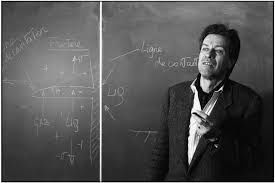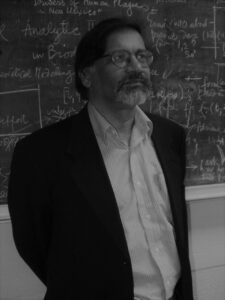Below I present three more insights from my exploratory research carried out to test the viability of the ‘I, Physicist’ project.
Per Bak (1948 – 2002), a Danish theoretical physicist who co-authored the 1987 academic paper that coined the term “Self-Organized Criticality”
Per Bak had a passion and love for physics. He liked to find very simple physical pictures of the problems he was working on.
“Unimportant matters often have deadlines, but doing physics has no deadline.”
“We don’t have good analytical skills, so we have to rely on physical pictures.”
“It is difficult to be a theorist, most of the time you don’t understand the problem; but once you understood it, it becomes trivial.”
“It is important to think what could be wrong about your work instead of thinking about what might be right.”
To his fellow Danish physicist Tomas Bohr (*), Per Bak
never started a new project without knowing exactly, what he was after, where he was going. He was extremely focused, and this brought a remarkable energy and clarity into the process. Of course even he didn’t always know the results beforehand, but the simplicity of the question he was asking and the clarity of the answer he was looking for made the chances of success large. It also meant that he knew exactly when he was done, when there was enough new material for an interesting paper. And “interesting” meant that it contained at least one clear new point or idea. Per was a true believer in publishing as the mode of communication in science….But of course to publish takes courage: If you come out and say something loud and clear, you run the risk of being publicly shown to be wrong! And Per had the courage to be loud and clear.
Per Bak hated “incremental physics.” As an editor at Physical Review Letters, he often asked: “Can you tell me, in one statement, what exactly you have done?”
Pierre-Gilles de Gennes (1932-2007), French physicist, Nobel Prize in Physics 1991 (**)
“I get accused of hopping from one subject to another. Other people spend 20 years on the same problem. Both approaches are necessary.”
De Gennes favored doing low-cost small science. Because of his approach, he often changed his research topics: from superconductivity to liquid crystals, to polymers, to interfacial phenomena, to neuroscience (collective neural growth and self-organization of axons). He disliked working alone. He preferred to put together mixed small groups of theoreticians and experimentalists to do research.
In a science as much in its infancy as soft matter, our current field of research, groups are typically quite small, composed of no more than four or five individuals— for example a chemist, an optical physicist, perhaps a condensed matter physicist, an electronics engineer, and, in a supporting role, a would-be theoretician. The more contrasts in the group, the better it performs. When a problem crops up that seems to stump everyone, one member is always ready to stimulate the others and to spark a discussion.
Small groups promote a special mood, not unlike that around a table at a tavern. Without the feedback and support of the team members, researchers would likely be driven to neurosis by the fierce competition both at the fundamental and applied levels. .. One of the most effective antidotes is teamwork. Individuals benefit from the support of their co-workers.
Vasudev M. Kenkre (1946-), Professor Emeritus, Distinguished Professor of Physics, The University of New Mexico
To be blessed with a sharp focus in life is given to only a few in this world. I am not one of them. This allows me to do only ‘sketches’ rather than finished perfections in whatever I undertake. Clearly, this is unfortunate. It is also fortunate: I am freed of the need to concentrate. I can hang loose and dip into that which pleases at a given moment.
From Carpet Weaving:
I recall a comment made by a physicist colleague many years ago that a quality lacking in today’s graduate students was the ability to stay on the job until the carpet was woven completely….To be a good practicing physicist requires a multitude of qualities, tendencies, and skills, as I am sure to be a good practicing individual in any field of endeavor does. There is devotion to the subject, basic intelligence, curiosity, careful observation, intellectual honesty, creativity, and hard work. But there is one more with which I have always had trouble in my own development: refusal to be content with small achievements. The subtlety of the situation arises from the fact that the ability to be content with small achievements is also an important prerequisite to success as a practicing physicist. If one is always seeking after the grandiose, deep frustrations descend, in no time engulfing the individual in depression. One must learn to enjoy the little berries one picks in the field even as one prepares to hunt big game. What makes this whole business…fascinating is that side by side with developing contentment with small achievements one must develop dissatisfaction with them. It is subtle. The contentment must come from their being achievements, however small. The dissatisfaction from their being small, even though they are achievements. One must enjoy every little joke but must not stop until the entire story is written. One must derive contentment from every little integral that is evaluated but not stop until the entire theory is constructed.
This ability to enjoy each thread but not rest until the entire carpet is woven is very rare indeed. My own considerable capacity for enjoyment of work means that I can derive endless pleasure from noticing every morning afresh, and on my own, that exponentials and trigonometric functions are connected. Pleasure that keeps me going. But pleasure also that distracts me from the sure fact that these are, from the point of view of my own creative work, very useful trivialities. A John Bardeen does not stop until he has explained superconductivity, a Michelangelo until he has finished the Sistine Chapel.
I am distracted by this little memory function, which through its singularity explains a little but does not have the staggering breadth and detail of a fully woven carpet.
______________________________
SOBRE EL AUTOR: José G. Álvarez Cornett ( @Chegoyo en Twitter )
Miembro de COENER, y del grupo “Physics and Mathematics for Biomedical Consortium“. Representante de los Egresados ante el Consejo de Escuela de Física, Facultad de Ciencias, UCV. Docente de Historia de la Ciencia en la Escuela de Física, Facultad de Ciencias, UCV.
@Chegoyo 2020






Recent Comments